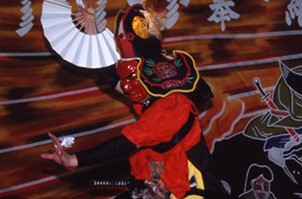
| Classification | Kagura |
|---|---|
| name | Kuromori Kagura (Kuromori Kagura) |
| Designated date | March 6, 1987 |
| Holding group | Kuromori Kagura Preservation Society |
| location | Miyako-shi Yamaguchi |
| home page | Kuromori Kagura |
watch video
Ebisu Mai (Ebi Sumai)
Mountain dance (Yama no kamii)
Yaoki Great Serpent extermination
Overview
Kuromori Kagura has originally been handed down by a group of Shuinsanbushi, headed by a good friend of Kuromori Shrine in Yamaguchi, Miyako-shi, and taking Kuromoriyama as a place, but now it is Miyako city, Iwaizumicho Omoto, etc. It has been passed down by volunteers. There is a custom of worshiping Gongen of the Kuromori Shrine (Mushiko), and there is a custom of making a village, and that village is the year of the treasured year (1673-1782) 81) It can be seen that the villages of Noda Dori, Miyako Dori, and Otsudori have been crawling since before. In addition, since the oldest inscription is 22 civilization 17 (1485) years at present with a lion head, the origin of Kuromori Kagura is considered to be in the middle of the Muromachi period. This Kagura is one of the few Kagura groups that inherits the tradition of Kasumi's mastership in the present age through Kagura, and is very important because it includes dance, dance, tombs, torso, pillars, firebush prayers, and so on. It is valuable in the history of performing arts, as it has various ceremonial customs and is rich in programs. We dance Kuromori Shrine now after the New Year, and go around Kitakyuri (Miyako-shi-Fushiro-mura) and Minami-ori (Miyako-shi-Oyodo-cho) by one year alternation for 1-2 months.
Main performance place
Kuromori Shrine annual festival (July), Kasumi cruise between winter (January-)
